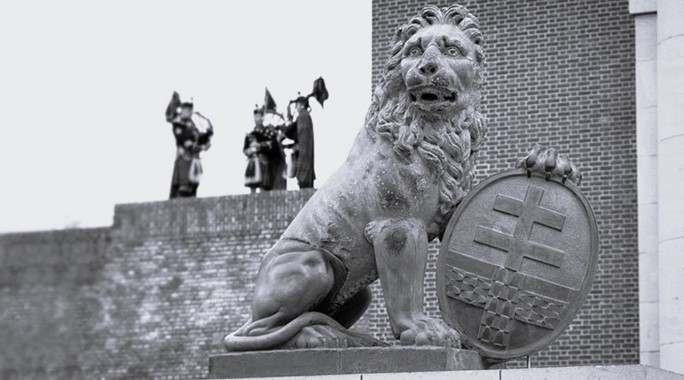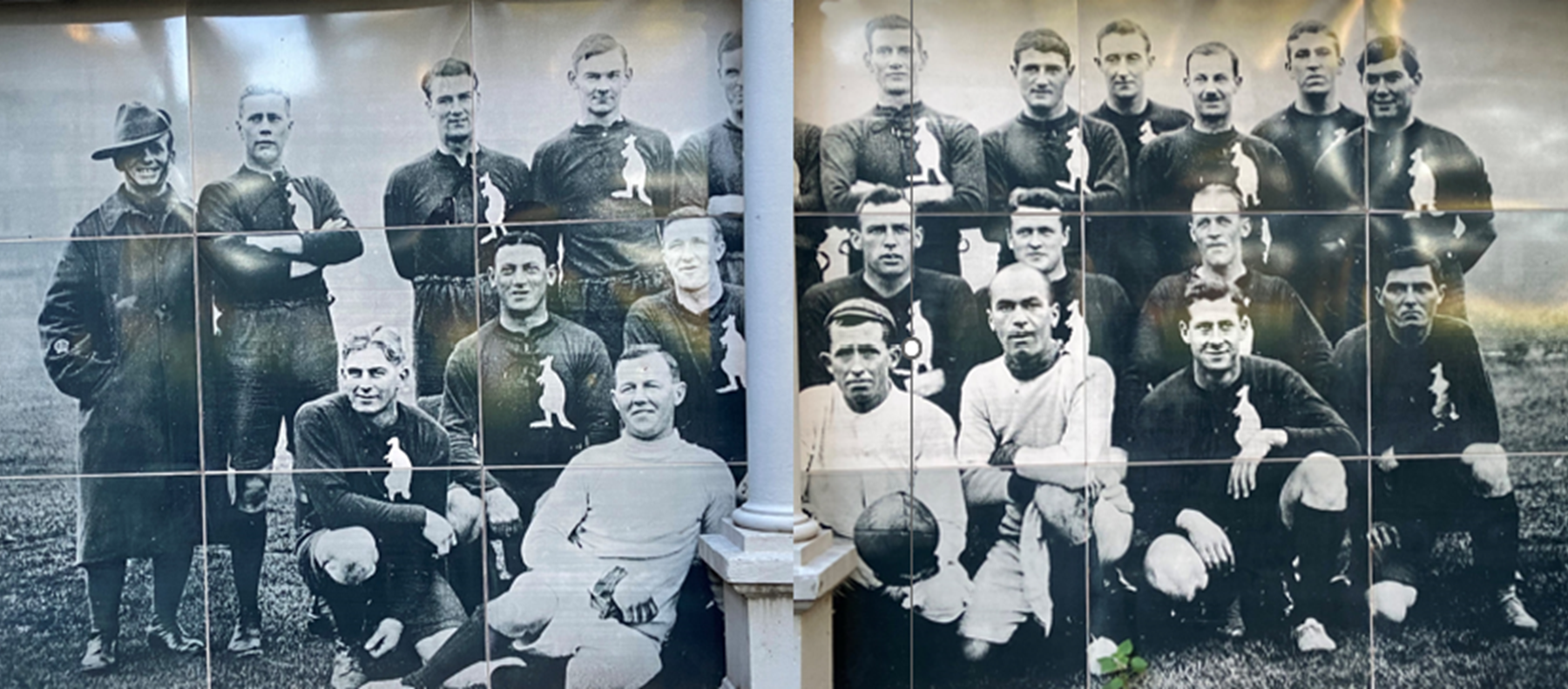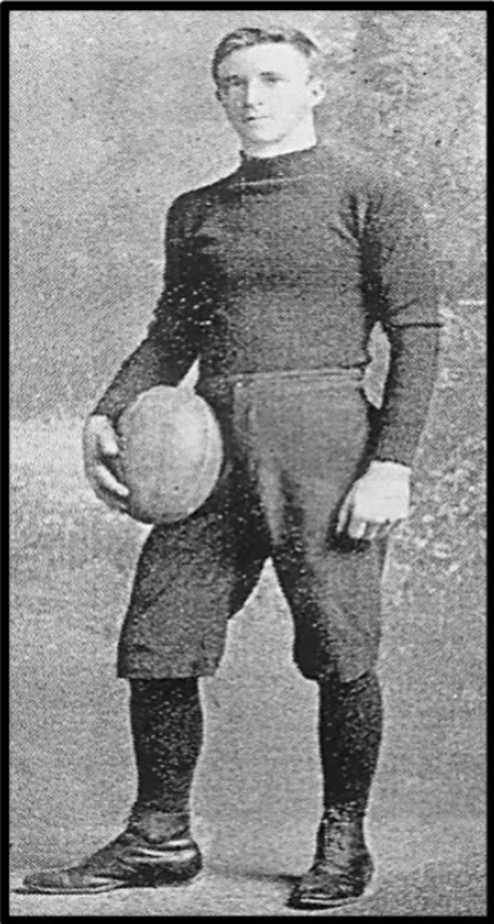
The Menin Gate Lions
Anzac Day at Fitzroy
April 26, 2024
You may have noticed, close to our grandstand, the young faces of Fitzroy players, overlooking Brunswick Street Oval.

On Anzac Day, we remember these players, who remind us of the sacrifice of our forebears.
Club Captain – Jack Cooper
The forebears, include past players like courageous Fitzroy footballer, Club Captain and Australian soldier, Jack Cooper.
John Thomas (aka Jack) Cooper was born in 1889. He was the son of Fred and Florence Cooper of Fitzroy. He attended the Alfred Crescent State School No: 1490 in North Fitzroy. Newspapers of the period indicate that, Alfred Crescent school embraced the importance of sport and encouraged students to participate whenever possible. State School 1490 produced several outstanding names in cricket and football.
Times were hard in Fitzroy when Jack Cooper was a child. Sport and games were a welcome break from the daily grind of life in the inner suburbs and it is fair, to suggest that playing VFL football would have been the dream of many youngsters. Jack Cooper would have been excited about the opportunity to play for Fitzroy. His arrival at Brunswick Street Oval, as a teenager, was to prove a new and exciting chapter in his life.
Fitzroy Football
A thick-set man at 5 ft 10 in (178 cm) and 78 kg, Cooper was a champion half-back. Recruited from the local team North Fitzroy Juniors, he played his first senior VFL game for the Fitzroy Football Club against Collingwood on 27 April 1907 at Victoria Park. In his first season, he played eleven matches and scored one goal.
In 1912, after he was appointed captain of the Fitzroy senior team, a contemporary report spoke of the tough, speedy, skilful, and tenacious Cooper.
He played in the Fitzroy team that won the 1913 premiership by defeating St Kilda 7.14 (56) to 5.13 (43) in the 1913 Grand Final Match; he was one of Fitzroy’s best players in that match. He was the Fitzroy club’s best and fairest player in both the 1911 and 1914 seasons, and he was the Fitzroy team captain in 1912, and its vice-captain from 1913 to 1915.
He also played eight games for Victoria, including the match against South Australia at the Adelaide Oval on 10 August 1912, when he captained the Victorian team that lost to South Australia 9.8 (62) to 6.7 (43).
In his career with Fitzroy, he played 136 senior games and scored eight goals. He played his last senior VFL game for Fitzroy on Saturday 11 September 1915, in the 1915 Preliminary Final, that was won by Carlton 6.18 (54) to 5.8 (38).
World War 1
 Leaving his employment as a storeman, he enlisted in the 8th Battalion of the First AIF on 8 November 1915 and left for France on the troopship Wiltshire on 7 March 1916.
Leaving his employment as a storeman, he enlisted in the 8th Battalion of the First AIF on 8 November 1915 and left for France on the troopship Wiltshire on 7 March 1916.
In France, Cooper saw action in the Battle of the Somme. He was only in the trenches for a short time when he was so badly gassed that once his immediate discomfort had been dealt with, he was repatriated to England to allow him to recuperate.
Having recuperated fully, he played for the (losing) Australian Training Units team in the famous “Pioneer Exhibition Game” of Australian Rules football, held in London, in October 1916, just before returning to active service in France.
He returned to France once more and was killed in action in Belgium, at Polygon Wood, during the Battle of Passchendaele on 20 September 1917.
His remains were never recovered.
He is commemorated in the Menin Gate Memorial to the Missing in Ypres, Belgium; and his name appears at panel 52 in the Commemorative Area at the Australian War Memorial. Jack’s death is a heart-rending story; and the fact that no one knows where he fell in combat is a profound tragedy. However, Jack’s story is one among many tragic cases.
It is believed that of the 62,000 Australian soldiers who perished in the Great War. 23,000 bodies were never recovered for burial.
Menin Gate Ypres France
Near the Menin Gate Memorial, where Fitzroy Club Captain Jack Cooper rest, is an archway, where two lions proudly stand.

The Menin Gate Lions
The Menin Gate was so named because here the road out of Ypres passed through the old wall defenses going in the direction of Menin.
During the war, the two stone lions standing on each side of the Menin Gate, watched over tens of thousands of Australian Diggers as they went towards the front line.
Rubbing the Lions Foot for Luck
The WW1 diggers rubbed the lion’s foot for good luck, as they walked through the gate, beyond which these men’s fate lay, and which became highly symbolic. They now, stand in the entrance way to the Australian War memorial in Canberra, where you can still see the shiny foot, polished from the many hands of the diggers.
Proud Lions
When the First World War broke out and the Germans invaded Belgium, the locals filled the mouths of the lions with straw in the belief that the Germans would never enter Ypres until the lions had eaten the straw, or so the legend goes.
The Germans ignored this and on 7th October 1914, German Uhlans entered the city through the Menin Gate. This was the only time the Germans occupied the city through the war. They left in a hurry on 13th October when a British Cavalry division approached the town and entered it.
The lions survived the First Battle of Ypres and had no damage inflicted on them. The lions also survived the Second Battle of Ypres and despite the ‘Big Bertha’ howitzers inflicting much damage on the town, they failed to knock the lions off their pedestals.
However, German artillery began to target the gate because it was a choke point and all the soldiers coming in and out of Ypres had to pass through. By the time the Third Battle of Ypres (Passchendaele) had come to a close the lions had disappeared into the rubble of which the ramparts and the causeway had become.
When hostilities ended, the lions were left in place, until they were eventually extracted from the rubble and brought to the Cloth Hall.
The north lion had lost his front paw and the southern lion had been reduced to a head and a piece of hind quarters.
Standing Strong
Despite being bombed, and in a warzone, the lions, although slightly ruffled; were never knocked off their pedestal.
Remember the diggers, who walk past those lions.
A lion never loses his spirit, in adversity.
We can rub the lion’s foot for good luck, on our jumper, which sits over our heart, and on our club emblem.
On Anzac Day, we remember, those before us, and especially the Fitzroy players, like Fitzroy Caption Jack Cooper who went to war, and paid the ultimate sacrifice.
